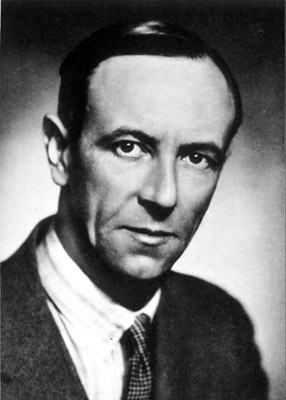A close competition between great physicists …
James Chadwick, who discovered the neutron in 1932, was Rutherford’s assistant and one of his most brilliant disciples. On June 3, 1920 he heard Rutherford, in the circle of regulars Bakerian Lectures of the Royal Society, express the idea of a kind of atom of mass 1 and charge 0, which was not hydrogen: this object being not subject to the electrical repulsion that suffered protons and alpha particles, was able to approach nuclei and enter easily into it. Chadwick remembered 12 years later this statement, when he had to interpret the results of his experiments.

James Chadwick (1891 – 1974)
James Chadwick is best known for his discovery of the neutron in 1932, for which he received the Nobel Prize in 1935. Born in Manchester, he was one of the most brilliant disciples of Ernest Rutherford, with whom he worked from 1909 to 1935. Chadwick was one of the first in Britain to stress the possibility of developing an atomic bomb. Between 1943 and 1945 he was head of the British delegation at Los Alamos working on the Manhattan Project.
© Musée Curie
The discovery of the neutron was the result of three sets of experiments done in three different countries, one leading to another. In this sense, it exemplifies the pursuit of knowledge.
In 1930, in Germany, W. Bothe and H.Becker, specialists of cosmic rays, observed that light elements bombarded by alpha particles emit « highly penetrating rays » that they assume to be gamma rays much more energetic than those emitted by radioactive nuclei or accompanying nuclear transmutations.
In 1931, in France, Irene and Frederic Joliot-Curie intrigued by these results try to understand the nature of this radiation and discover that it has the property to set atomic nuclei and particularly protons in motion… They assume that this could be a Compton effect between a gamma which they consider to have an energy of about 50 million electron volts (a very high energy for the time) and hydrogen. In the case of a proton, the kinematics of the collision is such that the photon must have such a high energy for communicating a kick to protons such as the one observed by Frederic and Irene Joliot-Curie. In the 1930s, there was not known sources of gamma of 50 million electron volts (Typically, the energies of gamma emitted by the nuclei are less than one million electron volts)
In 1932, once published these results, J. Chadwick in England made a test confirming those results and went further. By accurately measuring the energy of the ejected nuclei, he could say that the « ultra penetrating radiation » cannot be a gamma ray, of high energy, but must be composed of particle of mass 1 and of electric charge 0: this is the neutron.
All three teams had worked with the devices they have developed, but also with their own knowledge and were immersed in the tradition of their laboratories. It is not surprising that it was in the Cambridge laboratory, led by Rutherford, that the neutron was discovered. Chadwick had well remembered that Rutherford, indeed, had put forward a 13-year-old hypothesis of neutral particle about as heavy as a proton (In the 1920s, it was assumed that the nucleus was composed of protons accompanied by some electrons compensating some of the positive electric charges).
Physicists immediately give up their image of a nucleus made up of protons accompanied by captive electrons whose negative electric charge compensated for the positive charge of the protons. We owe to Chadwick and also to Rutherford, our modern image of the atomic nucleus composed of protons and neutrons!
Other articles on the subject « Discoveries »
Marie Curie
Marie Curie Marie Sklodowska-Curie had an exceptional destiny. Born in Poland, she came to gradua[...]
Three radiations
Understanding the nature of alpha, beta and gamma rays In the years following the discovery of ra[...]
Discovery of the Nucleus
A new vision of the atom In 1911, Rutherford, Marsden and Geiger discovered the dense atomic nucl[...]
Ernest Rutherford
In October 1895, landed in England a 24 years-old young New Zealander. His name was Ernest Ruther[...]
Rutherford’s experiment
The experiment which proved the existence of a nucleus in the atom In 1908, Ernest Rutherford rec[...]
Radium and Medicine
A short history: first steps in nuclear medicine … Everyone knows that the discovery of rad[...]
1934 : Artificial Radioactivity
The production at will of radioactive isotopes In the first days of 1934, Frederic and Irene Joli[...]
The Neutrino Hypothesis
The remarkable story of the neutrino The study of radioactive disintegrations had established tha[...]
Fission discovery
A nuclear phenomenon that escaped the hands of physicists In the years spanning 1934 to 1938, Enr[...]
Enrico Fermi
A genial experimenter and theoretician Enrico Fermi (Rome, September 29, 1901 – Chicago, No[...]